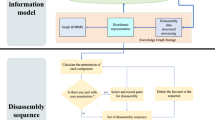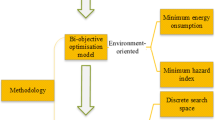Abstract
Increasing numbers of lithium-ion batteries for new energy vehicles that have been retired pose a threat to the ecological environment, making their disassembly and recycling methods a research priority. Due to the variation in models and service procedures, numerous lithium-ion battery brands, models, and retirement states exist. This uncertainty contributes to the complexity of the disassembly procedure, which calls for a great deal of adaptability. Human–Robot Collaboration Disassembly (HRCD) mode maximizes the advantages of both humans and robots, progressively replacing single-person disassembly and single-machine disassembly to become the standard method for disassembling end-of-life lithium-ion batteries (LIBs). However, the HRCD process has more dimensions and uncertainties. In light of the obstacles above, this paper developed an HRCD environment with virtual and real interaction functions, which recommended real-time cooperation strategies in the dynamic production process and significantly enhanced the flexibility of disassembly operations. Based on the genetic algorithm (GA), the Disassembly Sequence Planning (DSP) is developed for waste LIBs in the source domain and imported into the knowledge base. Then, the rapid adaptive generation of HRCD task strategy for LIBs is generated, utilizing the transfer learning approach in the target domain. Two types of end-of-life automobile LIBs are analyzed as case study products. The results demonstrated that the proposed method could plan an effective action sequence, effectively reduce the design time of the target domain disassembly strategy, and enhance the flexibility of HRCD.
















Similar content being viewed by others
References
Bänziger, T., Kunz, A., & Wegener, K. (2020). Optimizing human–robot task allocation using a simulation tool based on standardized work descriptions. Journal of Intelligent Manufacturing, 31(7), 1635–1648.
Bilberg, A., & Malik, A. A. (2019). Digital twin driven human–robot collaborative assembly. CIRP Annals, 68(1), 499–502.
Che, Z. H., Chiang, T. A., & Lin, T. T. (2021). A multi-objective genetic algorithm for assembly planning and supplier selection with capacity constraints. Applied Soft Computing, 101, 107030.
Chhim, P., Chinnam, R. B., & Sadawi, N. (2019). Product design and manufacturing process based ontology for manufacturing knowledge reuse. Journal of Intelligent Manufacturing, 30(2), 905–916.
Ge, W., & Yu, Y. (2017). Borrowing treasures from the wealthy: Deep transfer learning through selective joint fine-tuning. In Proceedings of the IEEE conference on computer vision and pattern recognition (pp. 1086–1095).
Grieves, M. (2014). Digital twin: Manufacturing excellence through virtual factory replication. White Paper, 1(2014), 1–7.
Guo, M. H., Cai, J. X., Liu, Z. N., Mu, T. J., Martin, R. R., & Hu, S. M. (2021). Pct: Point cloud transformer. Computational Visual Media, 7(2), 187–199.
Hu, H., Li, Z., Qin, S., & Ma, L. (2021b). Construction of feature tensor descriptor and self-similarity analysis for 3d point cloud models. Journal of Computer-Aided Design & Computer Graphics, 33(4), 590–600.
Hu, Y., Wang, Y., Hu, K., & Li, W. (2021a). Adaptive obstacle avoidance in path planning of collaborative robots for dynamic manufacturing. Journal of Intelligent Manufacturing, 1, 1–19.
Huang, J., Pham, D. T., Li, R., Qu, M., Wang, Y., Kerin, M., ... & Zhou, Z. (2021). An experimental human-robot collaborative disassembly cell. Computers & Industrial Engineering, 155, 107189.
IEA, Global electric car stock, 2010–2021, IEA, Paris https://www.iea.org/data-and-statistics/charts/global-electric-car-stock-2010-2021
Ji, Y., Yang, Y., Shen, H. T., & Harada, T. (2021). View-invariant action recognition via Unsupervised AttentioN Transfer (UANT). Pattern Recognition, 113, 107807.
Keselman, L., Iselin Woodfill, J., Grunnet-Jepsen, A., & Bhowmik, A. (2017). Intel realsense stereoscopic depth cameras. In Proceedings of the IEEE conference on computer vision and pattern recognition workshops (pp. 1–10).
Lander, L., Cleaver, T., Rajaeifar, M. A., Nguyen-Tien, V., Elliott, R. J., Heidrich, O., ... & Offer, G. (2021). Financial viability of electric vehicle lithium-ion battery recycling. Iscience, 24(7), 102787.
Laradji, I. H., & Babanezhad, R. (2020). M-ADDA: Unsupervised domain adaptation with deep metric learning. In Domain adaptation for visual understanding (pp. 17–31). Springer, Cham.
Lee, M. L., Behdad, S., Liang, X., & Zheng, M. (2020, July). Disassembly sequence planning considering human-robot collaboration. In 2020 American Control Conference (ACC) (pp. 2438–2443). IEEE.
Lee, M. L., Behdad, S., Liang, X., & Zheng, M. (2022). Task allocation and planning for product disassembly with human–robot collaboration. Robotics and Computer-Integrated Manufacturing, 76, 102306.
Liu, S., Bao, J., & Zheng, P. (2023). A review of digital twin-driven machining: From digitization to intellectualization. In Journal of Manufacturing Systems, 67, 361–378.
Liu, S., Lu, Y., Zheng, P., Shen, H., & Bao, J. (2022a). Adaptive reconstruction of digital twins for machining systems: A transfer learning approach. Robotics and Computer-Integrated Manufacturing, 78, 102390.
Liu, S., Sun, Y., Zheng, P., Lu, Y., & Bao, J. (2022b). Establishing a reliable mechanism model of the digital twin machining system: An adaptive evaluation network approach. Journal of Manufacturing Systems, 62, 390–401.
Lv, Q., Zhang, R., Sun, X., Lu, Y., & Bao, J. (2021). A digital twin-driven human-robot collaborative assembly approach in the wake of COVID-19. Journal of Manufacturing Systems, 60, 837–851.
Odenthal, B., Mayer, M. P., Kabuß, W., Kausch, B., & Schlick, C. M. (2011, July). An empirical study of disassembling using an augmented vision system. In International Conference on Digital Human Modeling (pp. 399–408). Springer, Berlin.
Ordoñez, J., Gago, E. J., & Girard, A. (2016). Processes and technologies for the recycling and recovery of spent lithium-ion batteries. Renewable and Sustainable Energy Reviews, 60, 195–205.
Qian, J., Zhang, Z., Shi, L., & Song, D. (2021). An assembly timing planning method based on knowledge and mixed integer linear programming. Journal of Intelligent Manufacturing, 1, 1–25.
Raatz, A., Blankemeyer, S., Recker, T., Pischke, D., & Nyhuis, P. (2020). Task scheduling method for HRC workplaces based on capabilities and execution time assumptions for robots. CIRP Annals, 69(1), 13–16.
Ranz, F., Hummel, V., & Sihn, W. (2017). Capability-based task allocation in human-robot collaboration. Procedia Manufacturing, 9, 182–189.
Rastegarpanah, A., Gonzalez, H. C., & Stolkin, R. (2021). Semi-autonomous behaviour tree-based framework for sorting electric vehicle batteries components. Robotics, 10(2), 82.
Raziei, Z., & Moghaddam, M. (2021). Adaptable automation with modular deep reinforcement learning and policy transfer. Engineering Applications of Artificial Intelligence, 103, 104296.
Ren, M., Zhang, Q., & Zhang, J. (2019). An introductory survey of probability density function control. Systems Science & Control Engineering, 7(1), 158–170.
Rodríguez, I., Nottensteiner, K., Leidner, D., Durner, M., Stulp, F., & Albu-Schäffer, A. (2020). Pattern recognition for knowledge transfer in robotic assembly sequence planning. IEEE Robotics and Automation Letters, 5(2), 3666–3673.
Singh, A., Yu, A., Yang, J., Zhang, J., Kumar, A., & Levine, S. (2020). Cog: Connecting new skills to past experience with offline reinforcement learning. arXiv preprint arXiv:2010.14500.
Sun, X., Zhang, R., Liu, S., Lv, Q., Bao, J., & Li, J. (2022). A digital twin-driven human–robot collaborative assembly-commissioning method for complex products. The International Journal of Advanced Manufacturing Technology, 118(9), 3389–3402.
Tao, F., Zhang, M., Liu, Y., & Nee, A. Y. (2018). Digital twin driven prognostics and health management for complex equipment. CIRP Annals, 67(1), 169–172.
Uglanov, A., Kartashev, K., Campean, F., Doikin, A., Abdullatif, A., Angiolini, E., ... & Zhang, Q. (2022). Driver Behaviour Modelling: Travel Prediction Using Probability Density Function. In UK Workshop on Computational Intelligence (pp. 545–556). Springer, Cham.
Vo, A. V., Truong-Hong, L., Laefer, D. F., & Bertolotto, M. (2015). Octree-based region growing for point cloud segmentation. ISPRS Journal of Photogrammetry and Remote Sensing, 104, 88–100.
Vongbunyong, S., Kara, S., & Pagnucco, M. (2013). Basic behaviour control of the vision-based cognitive robotic disassembly automation. Assembly Automation., 33(1), 38–56.
Vongbunyong, S., Vongseela, P., & Sreerattana-aporn, J. (2017). A process demonstration platform for product disassembly skills transfer. Procedia CIRP, 61, 281–286.
Wu, Z., He, L., Wang, Y., Goh, M., & Ming, X. (2020). Knowledge recommendation for product development using integrated rough set-information entropy correction. Journal of Intelligent Manufacturing, 31(6), 1559–1578.
Xu, C., Wang, J., Zhang, J., & Li, X. (2021b). Anomaly detection of power consumption in yarn spinning using transfer learning. Computers & Industrial Engineering, 152, 107015.
Xu, W., Cui, J., Liu, B., Liu, J., Yao, B., & Zhou, Z. (2021a). Human-robot collaborative disassembly line balancing considering the safe strategy in remanufacturing. Journal of Cleaner Production, 324, 129158.
Xu, W., Tang, Q., Liu, J., Liu, Z., Zhou, Z., & Pham, D. T. (2020). Disassembly sequence planning using discrete Bees algorithm for human-robot collaboration in remanufacturing. Robotics and Computer-Integrated Manufacturing, 62, 101860.
Yao, B., Zhou, Z., Wang, L., Xu, W., Yan, J., & Liu, Q. (2018). A function block based cyber-physical production system for physical human–robot interaction. Journal of Manufacturing Systems, 48, 12–23.
Yu, T., Huang, J., & Chang, Q. (2020). Mastering the working sequence in human-robot collaborative assembly based on reinforcement learning. IEEE Access, 8, 163868–163877.
Yu, D., Huang, Z., Makuza, B., Guo, X., & Tian, Q. (2021). Pretreatment options for the recycling of spent lithium-ion batteries: A comprehensive review. Minerals Engineering, 173, 107218.
Zhang, R., Lv, Q., Li, J., Bao, J., Liu, T., & Liu, S. (2022). A reinforcement learning method for human-robot collaboration in assembly tasks. Robotics and Computer-Integrated Manufacturing, 73, 102227.
Zhu, L., & Chen, M. (2020). Research on Spent LiFePO4 Electric Vehicle Battery Disposal and Its Life Cycle Inventory Collection in China. International Journal of Environmental Research and Public Health, 17(23), 8828.
Zhu, W., Braun, B., Chiang, L. H., & Romagnoli, J. A. (2021). Investigation of transfer learning for image classification and impact on training sample size. Chemometrics and Intelligent Laboratory Systems, 211, 104269.
Funding
This work is financially supported by the Municipal Natural Science Foundation of Shanghai (21ZR1400800), in part by the Priming Scientific Research Foundation for the Junior Researchers of Donghua University and Graduate Student Innovation Fund of Donghua University (CUSF-DH-D-2022072).
Author information
Authors and Affiliations
Contributions
WQ: Conceptualization, Methodology, Data curation, Writing—original draft, Writing—review & editing. JL: Conceptualization, Methodology, Writing—original draft, Writing—review & editing, Funding acquisition. RZ: Conceptualization, Resources. SL: Visualization, Validation. JB: Project administration.
Corresponding author
Ethics declarations
Conflict of interest
The authors of this paper have no relevant financial or non-financial interests to disclose.
Additional information
Publisher's Note
Springer Nature remains neutral with regard to jurisdictional claims in published maps and institutional affiliations.
Rights and permissions
Springer Nature or its licensor (e.g. a society or other partner) holds exclusive rights to this article under a publishing agreement with the author(s) or other rightsholder(s); author self-archiving of the accepted manuscript version of this article is solely governed by the terms of such publishing agreement and applicable law.
About this article
Cite this article
Qu, W., Li, J., Zhang, R. et al. Adaptive planning of human–robot collaborative disassembly for end-of-life lithium-ion batteries based on digital twin. J Intell Manuf 35, 2021–2043 (2024). https://doi.org/10.1007/s10845-023-02081-9
Received:
Accepted:
Published:
Issue Date:
DOI: https://doi.org/10.1007/s10845-023-02081-9




